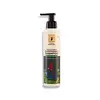What's inside
What's inside
 Key Ingredients
Key Ingredients

No key ingredients
 Benefits
Benefits

 Concerns
Concerns

 Ingredients Side-by-side
Ingredients Side-by-side

Hibiscus Rosa-Sinensis Leaf Extract
BleachingMurraya Exotica Leaf Extract
AntioxidantAzadirachta Indica Leaf Extract
Skin ConditioningRosmarinus Officinalis Leaf Extract
AntimicrobialAcetum
Sapindus Mukorossi Fruit Extract
Skin ConditioningEmblica Officinalis Fruit Extract
Skin ConditioningAcacia Concinna Fruit Extract
Skin ConditioningBacillus/Coix Lacryma-Jobi Ma-Yuen Seed/Soybean Ferment Filtrate
AntioxidantGlycine Soja Extract
Skin ConditioningCocos Nucifera Oil
MaskingCaprylic/Capric Triglyceride
MaskingSodium Lauroyl Sarcosinate
CleansingCocamidopropyl Betaine
CleansingOlea Europaea Fruit Oil
MaskingAnanas Sativus Fruit Extract
Skin ConditioningOcimum Sanctum Leaf Extract
Skin ConditioningDecyl Glucoside
CleansingGuar Hydroxypropyltrimonium Chloride
Skin ConditioningSodium Cocoyl Isethionate
CleansingPolyquaternium-10
Xanthan Gum
EmulsifyingGlycerin
HumectantPhenoxyethanol
PreservativeEthylhexylglycerin
Skin ConditioningCellulose Gum
Emulsion StabilisingMagnesium Sulfate
Tocopheryl Acetate
AntioxidantHibiscus Rosa-Sinensis Leaf Extract, Murraya Exotica Leaf Extract, Azadirachta Indica Leaf Extract, Rosmarinus Officinalis Leaf Extract, Acetum, Sapindus Mukorossi Fruit Extract, Emblica Officinalis Fruit Extract, Acacia Concinna Fruit Extract, Bacillus/Coix Lacryma-Jobi Ma-Yuen Seed/Soybean Ferment Filtrate, Glycine Soja Extract, Cocos Nucifera Oil, Caprylic/Capric Triglyceride, Sodium Lauroyl Sarcosinate, Cocamidopropyl Betaine, Olea Europaea Fruit Oil, Ananas Sativus Fruit Extract, Ocimum Sanctum Leaf Extract, Decyl Glucoside, Guar Hydroxypropyltrimonium Chloride, Sodium Cocoyl Isethionate, Polyquaternium-10, Xanthan Gum, Glycerin, Phenoxyethanol, Ethylhexylglycerin, Cellulose Gum, Magnesium Sulfate, Tocopheryl Acetate
Water
Skin ConditioningSodium Cocoyl Isethionate
CleansingCocamidopropyl Betaine
CleansingSodium Lauroyl Sarcosinate
CleansingGlycol Distearate
EmollientCapryloyl/Caproyl Methyl Glucamide
EmulsifyingLauroyl/Myristoyl Methyl Glucamide
EmollientPEG-150 Distearate
EmulsifyingPEG-12 Dimethicone
Skin ConditioningDipropylene Glycol
HumectantPolysilicone-29
Bis-Cetearyl Amodimethicone
Polyquaternium-7
Coco-Glucoside
CleansingGlyceryl Oleate
EmollientSerenoa Serrulata Fruit Extract
Skin ConditioningPhenoxyethanol
PreservativeParfum
MaskingQuaternium-98
EmollientPolyquaternium-113
Stearamidopropyl Dimethylamine
EmulsifyingCitric Acid
BufferingCetrimonium Chloride
AntimicrobialArgania Spinosa Kernel Oil
EmollientOenocarpus Bataua Fruit Oil
EmollientHydrolyzed Keratin
HumectantHydrolyzed Plukenetia Volubilis Seed Extract
Emulsion StabilisingWater, Sodium Cocoyl Isethionate, Cocamidopropyl Betaine, Sodium Lauroyl Sarcosinate, Glycol Distearate, Capryloyl/Caproyl Methyl Glucamide, Lauroyl/Myristoyl Methyl Glucamide, PEG-150 Distearate, PEG-12 Dimethicone, Dipropylene Glycol, Polysilicone-29, Bis-Cetearyl Amodimethicone, Polyquaternium-7, Coco-Glucoside, Glyceryl Oleate, Serenoa Serrulata Fruit Extract, Phenoxyethanol, Parfum, Quaternium-98, Polyquaternium-113, Stearamidopropyl Dimethylamine, Citric Acid, Cetrimonium Chloride, Argania Spinosa Kernel Oil, Oenocarpus Bataua Fruit Oil, Hydrolyzed Keratin, Hydrolyzed Plukenetia Volubilis Seed Extract
Ingredients Explained
These ingredients are found in both products.
Ingredients higher up in an ingredient list are typically present in a larger amount.
Cocamidopropyl Betaine is a fatty acid created by mixing similar compounds in coconut oil and dimethylaminopropylamine, a compound with two amino groups.
This ingredient is a surfactant and cleanser. It helps gather the dirt, pollutants, and other impurities in your skin to be washed away. It also helps thicken a product and make the texture more creamy.
Being created from coconut oil means Cocamidopropyl Betaine is hydrating for the skin.
While Cocamidopropyl Betaine was believed to be an allergen, a study from 2012 disproved this. It found two compounds in unpure Cocamidopropyl Betaine to be the irritants: aminoamide and 3-dimethylaminopropylamine. High-grade and pure Cocamidopropyl Betaine did not induce allergic reactions during this study.
Learn more about Cocamidopropyl BetainePhenoxyethanol is a preservative that has germicide, antimicrobial, and aromatic properties. Studies show that phenoxyethanol can prevent microbial growth. By itself, it has a scent that is similar to that of a rose.
It's often used in formulations along with Caprylyl Glycol to preserve the shelf life of products.
Sodium cocoyl isethionate is a natural ingredient from coconut oil. It is an ultra gentle cleanser that gives a nice foam without drying the skin or impacting the skin barrier.
The amount of foam created depends on the amount of sodium cocoyl isethionate used in the product.
This ingredient also helps improve the spreadability of a product.
Learn more about Sodium Cocoyl IsethionateSodium Lauroyl Sarcosinate is a cleansing agent and emulsifier. It is a surfactant derived from sarcosine, and a common source is coconut oil.
As a surfactant, Sodium Lauroyl Sarcosinate helps lift dirts, oil, and other molecules to be washed away. In leave-on products, this ingredient is used as an emulsifier. Emulsifier help prevent ingredients such as oils and waters from separating.
Sodium Lauroyl Sarcosinate is also commonly found as a foaming agent in shampoo, toothpaste, and shaving foam. It is amphiphilic, meaning it loves both water and fats.
Learn more about Sodium Lauroyl Sarcosinate